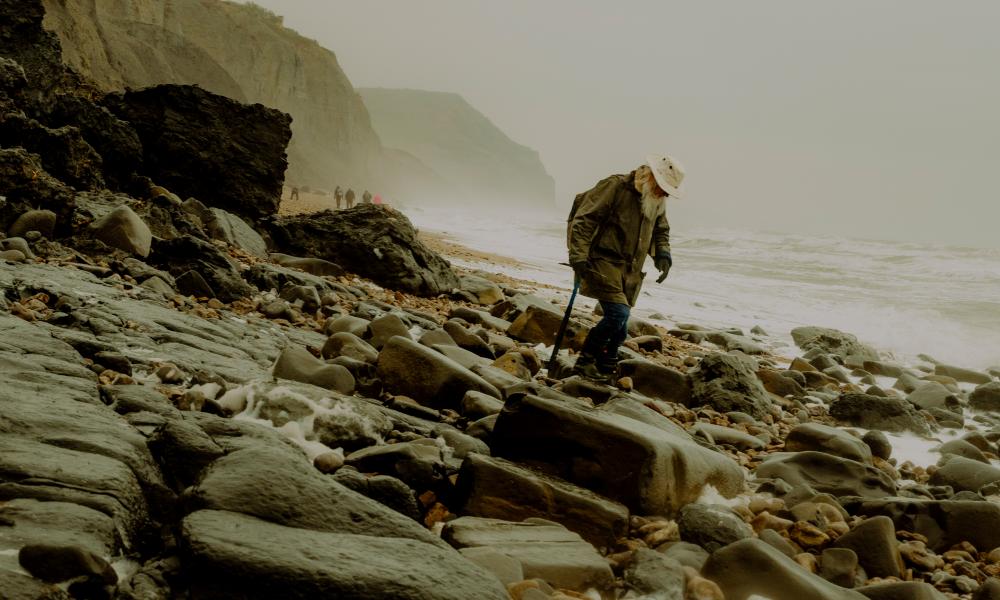
THE FOSSIL FINDER: ONE MAN’S LIFELONG SEARCH FOR FRAGMENTS OF BRITAIN’S JURASSIC PAST – PHOTO ESSAY
When Richard Forrest walks along the Lyme Regis beach on the Jurassic coast in Dorset, he carries in his small backpack a pointed pick, a geological hammer and an old kitchen knife. But he very rarely uses them until he is back home with a rock or two to work on. “The most important thing to take with you is your eyes,” he says. “And learn what it is you’re looking for.”
Forrest is a fossil finder and has spent more than 50 years on Britain’s beaches hunting for evidence of the country’s prehistoric past. The Jurassic coast, stretching 95 miles (150km) across Devon and Dorset, is world famous for its treasure trove of ammonites and other fossils that lie, in many places, conspicuous beneath visitors’ feet. Others are hidden within the cliffs, only exposed after heavy rains bring on one of the regular landslips. “The best feeling is when you find something you think is potentially interesting and then you get it home and discover that wow, this is really interesting,” he says. “That feeling is amazing.”
On the day that we take a walk along the beach, the sun is dipping in and out from behind a blanket of pale grey clouds and there is a fresh breeze in the air. A dozen people in raincoats wander across the rocks slowly, crouching down intermittently to examine what’s at their feet.
The view from Lyme Regis, looking east
The coast attracts thousands of visitors a year who descend on the most popular fossil beaches of Lyme Regis and Charmouth, often with picks and hammers. Some of them come to find what they may view as prehistoric treasure, others to walk in the footsteps of Dorset’s famous daughter, Mary Anning, who became known around the world for the discoveries she made here in the early 19th century.
But few have the level of expertise of the truly dedicated fossil finder. Walking with Forrest is like having the lights turned on in a shop full of jewels – suddenly seeing treasures surrounding you.
Recalling the first time he came to Charmouth as a teenager with his then-girlfriend’s brother, Forrest says: “I remember he said ‘hit that rock and there’s an ammonite inside it’. So I hit it and a beautiful ammonite appeared and he said ‘that’s the first time it has seen the light of day in 180m years’. That felt like fireworks going off. It was really extraordinary to me.”
Richard Forrest holds a fossil sponge, aged at around 100m years, and carries a pick, used for digging out rocks, across Lyme Regis beach
Even the most experienced fossil hunter is not always successful, as the tiny fragment of rib framed in Forrest’s downstairs toilet attests. The words around it read: ‘Total finds from four days of collecting at Lyme Regis and Charmouth. Sometimes it’s only the beer that makes it worthwhile.”
“It’s always frustrating to come back again and again empty handed,” he says. “But you learn to deal with that because what matters, at the end of the day, is the number of hours you spend out there looking.”
Richard Forrest stands in front of a cliff with visible signs of coastal erosion
For Forrest, fossil finding is much more than a pastime. It helped him recover from a deep personal tragedy, which left him repressing feelings that came back to haunt him later in life.
He found a love of fossils thanks to a palaentologist at his local museum, Arthur Cruickshank, who took him under his wing and encouraged him to piece together a plesiosaur, bone fragment by fragment. Forrest later went on to become one of the country’s leading experts on the marine reptiles, subsequently writing academic papers on his findings and giving talks.
Once hours of scouring the beach are done, we head over to Charmouth to see Forrest’s friend of 20 years, Chris Moore. A fellow fossil hunter, Moore is a longtime friend of David Attenborough who has made two documentaries with him, Attenborough and the Giant Sea Monster, which aired earlier this year, and Attenborough and the Sea Dragon. The latter is about an icthyosaurus Moore and his son Alex discovered, and whose painstakingly reconstructed bones are now displayed in the Charmouth Heritage Coast Centre.
The interior of Chris and Alex Moore’s shop in Charmouth
Tools used in the workshop; prehistoric fauna and flora on sale in the shop; Richard Forrest holds up an ammonite; Chris Moore at work
The Moores have a workshop, an extraordinary place, hidden behind the unassuming facade of a house like any other in its row. Father and son spend hours preparing fossils that are embedded in rock. The adjoining shop, with rough stone floors and walls, is an Aladdin’s cave of paleantology. On sale are everything from small ammonites priced £30 to £40, to skeletons that fetch several thousand pounds.
A Mancunian, Moore was drawn to the Jurassic coast when he decided to make a living from his hobby. Like Forrest, he taught himself. “In spite of the fact that people tend to think fossils just pop open and are there, revealed, they actually take between a few hours and hundreds of thousands of hours of work to prepare them,” he says.
A pick is among the tools used to clear fossils from rocks; Richard Forrest in the shop in Charmouth, which he visits several times a year
A view from Lyme Regis, east along the coastline
The work can be painstaking and you can’t “go at it madly”, says Moore, or you will damage the fossils. When he first started out in fossil preparation, he had a hammer and a sharp point. Now he has equipment that includes compressors, micro sandblasters and air chisels. The pair have become world renowned in their craft, with specimens on display in Tokyo’s Science Museum and the Royal Ontario Museum. Moore senior has even discovered his own new specimen of icthyosaur, which now lives in the Natural History Museum, and which bears his name in Latin: Leptonectes moorei.
Related: Life under the pier: ‘It never occurred to me what might be here’
Out on the sand and shingle of Charmouth beach, Forrest contemplates the sky as the heavens open. The water from the clouds and from the sea is a constant medium for change, resulting in ongoing and often substantial alterations to the coastline over time.
Places Forrest had previously been to look for fossils have now completely disappeared, he says. For a fossil hunter, this brings mixed feelings. “If someone’s house slides into the sea, of course you feel extremely sorry for them. But at the same time it [the erosion] is exposing new information for us to find.” It is this constant shifting of earth, rocks and sands that brings the same people back to the same part of the Jurassic coast again and again. “You never know what you’re going to find,” he says. “And to me that’s the exciting bit about it.”
Lyme Regis, probably the best known British town for visitors interested in fossils
